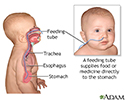Feeding tube - infants
Gavage tube - infants; OG - infants; NG - infants
Information
A feeding tube is a small, soft, plastic tube placed through the nose (NG) or mouth (OG) into the stomach. These tubes are used to provide feedings and medicines into the stomach until the baby can take food by mouth.
WHY IS A FEEDING TUBE USED?
Feeding from the breast or bottle requires strength and coordination. Sick or premature babies may not be able to suck or swallow well enough to bottle or breastfeed. Tube feedings allow the baby to get some or all of their feeding into the stomach. This is the most efficient and safest way to provide good nutrition. Oral medicines can also be given through the tube.
Premature
A premature infant is a baby born before 37 completed weeks of gestation (more than 3 weeks before the due date).
HOW IS A FEEDING TUBE PLACED?
A feeding tube is gently placed through the nose or mouth into the stomach. An x-ray can confirm correct placement. In babies with feeding problems, the tip of the tube may be placed past the stomach into the small intestine. This provides slower, continuous feedings.
WHAT ARE THE RISKS OF A FEEDING TUBE?
Feeding tubes are generally very safe and effective. However, problems may occur, even when the tube is placed properly. These include:
- Irritation of the nose, mouth, or stomach, causing minor bleeding
- Stuffy nose or infection of the nose if the tube is placed through the nose
If the tube is misplaced and not in the proper position, the baby may have problems with:
- An abnormally slow heart rate (bradycardia)
- Breathing
- Spitting up
In rare cases, the feeding tube can puncture the stomach.
References
Kim YS. Nasogastric and nasoenteric tube insertion. In: Pfenninger JL, Fowler GC, eds. Pfenninger and Fowler's Procedures for Primary Care . 3rd ed. Philadelphia, PA: Elsevier Mosby; 2011:chap 203.
Poindexter BP, Ehrenkranz RA. Nutrient requirements and provision of nutritional support in the premature neonate. In: Martin RJ, Fanaroff AA, Walsh MC, eds. Fanaroff and Martin's Neonatal-Perinatal Medicine . 10th ed. Philadelphia, PA: Elsevier Saunders; 2015:chap 43.
-
Feeding tube - illustration
A feeding tube is a small, soft, plastic tube placed through the nose or mouth into the stomach. A feeding tube is used to provide food and medicine into the stomach until a person can take food by mouth.
Feeding tube
illustration
-
Ear infections
(In-Depth)
-
Gastroesophageal reflux disease and heartburn
(In-Depth)
-
Otitis media
(Alt. Medicine)
-
Anemia
(In-Depth)
-
Urinary tract infection
(In-Depth)
-
Appendicitis
(Alt. Medicine)
-
Lyme disease and related tick-borne infections
(In-Depth)
Review Date: 5/18/2016
Reviewed By: Neil K. Kaneshiro, MD, MHA, Clinical Assistant Professor of Pediatrics, University of Washington School of Medicine, Seattle, WA. Also reviewed by David Zieve, MD, MHA, Isla Ogilvie, PhD, and the A.D.A.M. Editorial team.

